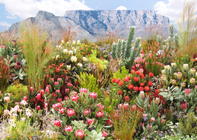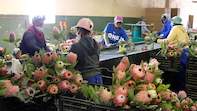The ancient plant family Proteaceae existed on earth 140 million years ago, even before the separation of the Gondwanaland continent. At that time, the plant family was already split into two subfamilies, the Proteoideae and the Grevilleoideae, both mainly found in the southern hemisphere.

Well-known pants of the Proteaceae family are the Leucospermum with its recognisable ‘pincushion’ flowers, Leucadendron with its yellow or red-brown foliage and Serruria florida - the ‘blushing bride’.
In the wild, the protea family has over 1 400 species growing all over the world. Some 400 species are found in Africa, 800 in Australia and others grow in South and Central America, in Southeast-Asia, New Guinea, New Zealand and Madagascar.
In terms of cultivated proteas, Englishman Joseph Knight tried to grow proteas under artificial conditions, in the late 1700s. He eventually succeeded, when the first species were shown at the Royal Botanical Gardens at Kew in 1774. He published a book on growing proteas in 1809, and by 1810, twenty-one species were grown in Kew Gardens.
History of Proteas in South Africa
During the 1960s in South Africa, protea sales were mainly dependent on wild-harvested stems, but commercial cultivation of proteas started with a few enterprising South Africans.
Seeing the potential of protea species for the commercial cut-flower market, retired deciduous fruit farmer, Frank Batchelor of Stellenbosch, laid the foundations for commercial protea production, in South Africa. During the 1940s to the 1970s, he selected, hybridized, and propagated wild-collected protea species to improve the quality.
In 1958 well-known protea specialist Dr Marie Vogts contributed to the technical knowledge of growing proteas with her book published “Proteas, Know Them and Grow Them”. The book highlighted the economic possibilities of proteas as cut-flowers and for landscaping.
South African Protea Producers and Exporters Association (SAPPEX) came into being in 1965 and in the early 1970s, the Agricultural Research Council’s Elsenburg fynbos unit was established. This unit supplied cuttings, mostly Leucospermum, to farmers for planting.
SAPPEX and the Protea Producers of South Africa (PPSA) merged in 2014 to form Cape Flora SA. Based in Paarl, the association looks after the needs of the fynbos and protea industry. This non-profit company is the umbrella organisation in South Africa, administrating levies to support marketing, research, communication and education initiatives.
International Protea Production History

In 1964 the University of Hawaii, became involved in commercial protea production and development of cultivars, when 34 species, grown from imported seed were selected for use in landscaping.
The International Protea Association (IPA) was formed in Melbourne, Australia in 1981. Still active today, the IPA supports the promotion, research, conservation and commercial production of proteas.
Protea research, specifically cultivar development, in South Africa and Hawaii and also Israel, encouraged protea cultivation for the international cut-flower industry in several other countries around the world.
The cut-flower industry in South Africa may have developed from the wild-harvesting of proteas and fynbos, but has since evolved to the commercial plantings of highly specialised hybrids with much less dependence on wild harvesting.
By Marinda Louw